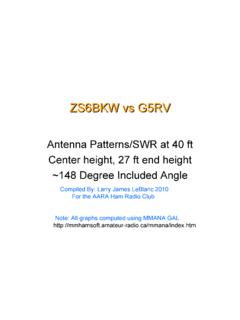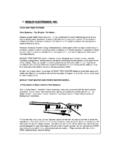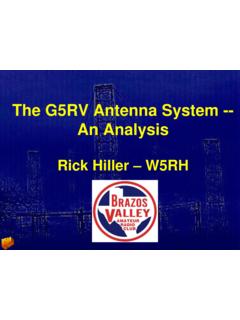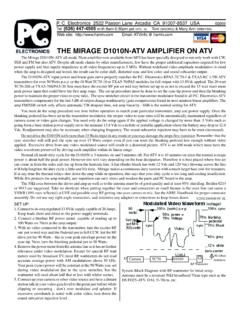Transcription of In-Building Wireless Signal Distribution
1 Introduction to In-Building Wireless Signal Distribution for Public Safety. A general design overview and Installation guideline. (See notice on last page). 2005, 2007 Jack Daniel Company Tel: 800-NON-TOLL. email: Page 1 2007 Jack Daniel Company Introduction: Wireless users expect and rely on communications wherever they go, including inside large structures, high rise buildings, underground parking, malls, basements, subways, etc. When Wireless radio frequency (RF) signals pass through any material they lose strength and when the RF Signal levels fell below a given amount, communications becomes unreliable or completely stops. Whenever the area needing radio coverage is below grade (underground) it is almost certain a RF Distribution system will be needed. The following discussion of RF (radio frequency) Distribution systems is intended as an introduction to the various solutions being used to improve RF Signal levels when necessary.
2 Page 2 2007 Jack Daniel Company The primary components of an amplified RF Distribution system are identified below: 1. Donor (roof) antenna. This is called the "DONOR" antenna. It is usually mounted on the roof, or a side of the structure, where a clear line-of-sight path exists to the distant radio tower. The distant site is also known as the "Donor". This is a two way interface;. - the DOWNLINK" is the RF Signal direction going INTO the structure. - the "UPLINK" is the RF Signal being sent back OUT of the structure. 2. BDA (Bi-Directional RF Amplifier). A very specialized RF amplifier which selects what frequencies are to be amplified in the downlink and uplink paths (they are different) and increases the RF Signal strength in both directions. The FCC calls these amplifiers ' Signal boosters' and there are very specific federal rules on their operation that should be followed by the system designer. 3. The RF Distribution network.
3 The most common method is to use coaxial cables. The coaxial cables fall into two classes; standard (non-radiating) and radiating. Standard (Non-radiating) coaxial cables route RF signals to multiple indoor antennas placed in areas where radio operation is needed. Page 3 2007 Jack Daniel Company Special devices that take a portion of the RF Signal out of the main coax cable to feed multiple antennas may be used. There are several types of these devices and they may be called "taps", "splitters" or "decouplers", all serving the same purpose. "Radiating" coaxial cables (sometimes called 'leaky coax') intentionally allows low level RF signals to 'leak' in and out along the path of the cable. The ideal location for radiating cables is in passageways, tunnels etc. The RF Signal looses strength going through coaxial cable. These losses increase with length and RF frequency. In most cases, the maximum usable length of a coaxial cable is less than 1000 feet.
4 Coaxial cables used for RF Distribution must be 50 ohm (not 75 ohm) type. Indoor antennas can be placed at the end of a coaxial cable or 'tapped' into a coaxial cable to allow multiple antennas along the coaxial cable route. This method is called Distributed Antenna System or "DAS". 800 MHz antennas are typically small and unobtrusive, some looking similar to smoke detectors. Ideally, the indoor antennas will be located where they are optically visible from every location you wish to communicate, however RF signals can travel through 2 - 4 wood or drywall walls but the Signal will be weakened. In parking garages, low profile (2" thick, 6 " diameter) antennas are sometimes glued to the lower side of overhead structural beams with construction adhesive. Locations of antennas sometimes follow the layout for video surveillance cameras, with both often serving the same area. Photo of a ceiling mounted low profile antenna. Page 4 2007 Jack Daniel Company "RF-Over-Fiber" Fiber Optic cables When a long coaxial cable would be required to connect antennas inside a larger structure, a long tunnels or adjacent buildings, it may be more practical to use 'RF-over-fiber' technology.
5 Instead of using coaxial cables, the signals are converted to light and transported over fiber optic cables. On longer distances, fiber often offers less cost and easier installation. Use of fiber optic cables is explained further later. Mixed RF Distribution type designs: All three types of cable may be combined as required by each project by the Distribution system designer. Basic Single Structure application;. Figure 1. In this example, a directional roof top antenna (Donor Antenna) is positioned so it has a line-of-sight path to the appropriate distant radio tower. A non-radiating coaxial cable connects the donor antenna to the BDA RF amplifier. Page 5 2007 Jack Daniel Company SPECIAL NOTE: The most frequent problem with an In-Building installation is inadequate isolation (path loss) between the roof antenna and those within the building . When insufficient the system 'oscillates' and causes interference to yourself and others.
6 It is illegal to operate a Signal booster that oscillates. Reduce gain settings to prevent oscillations. The industry standard for minimum antenna to antenna isolation ues this formula; BDA gain + 15 dB. Example, 80 dB BDA gain + 15 dB = 95 dB minimum ant ant isolation. Excessive gain does not improve performance and may present excessive noise to nearby receivers. Always use the minimum reliable gain setting. It is VERY important that the gain setting of the BDA be adjusted by a qualified radio technician. Factory certified technicians are recommended when available. Contact the Signal booster manufacturer for a list of certified technicians in your area. Remember, the Federal Communications Commission (FCC) can impose fines and confiscate equipment that causes interference. ---------------------------------------- ---------------------------------------- -------------------------- Page 6 2007 Jack Daniel Company The other side of the BDA connects to the internal RF Distribution system.
7 In the example, a Distributed Antenna System (DAS) approach is used. The black lines are non-radiating coaxial cables. The green boxes are decouplers which take off a portion of the RF Signal on each floor. The decoupled Signal is routed through coaxial cable to an indoor antenna (yellow discs). In real applications, the system is designed to have sufficient RF coverage from each inside antenna. Other devices, such as power dividers and antenna taps, may be used to place multiple antennas on each floor. Single structure Fiber Optic application. In some structures it may be better to use "RF-over-fiber" technology to overcome long coaxial cables which lose too much RF Signal , are harder to install and often more expensive. Unlike coaxial cables, fiber Distribution includes low level RF amplification which results in zero Distribution loss. Figure 2. Orange cables are 2 fiber single mode cables Blue boxes are Remote Hubs. Page 7 2007 Jack Daniel Company A fiber installation is similar to coaxial cables EXCEPT each fiber run between the BDA and each inside antenna is a separate 'home run' type path.
8 In practice a 4 to 6 fiber single mode fibers is installed for each path; 2 are in use and the rest are spares. Multimode fibers cannot be used for this application. The fiber device near the inside antennas is called a 'remote hub' and can serve as many as 4 inside antennas per remote hub. The inside antennas are connected to the remote hub with non-radiating coaxial cable. The exact combination of remote hubs, inside antennas and length of coaxial cables is designed by an In-Building Distribution engineer. Note: A combination splice tray and fiber patch panel is recommended at the BDA to manage the various fiber cable runs. Fiber cable terminations and short fiber jumpers are required at each remote hub as well as a 110 VAC 1 Amp power source. In exposed areas, such as parking garages, all this and a DC power supply is often mounted inside a small NEMA 12 utility box. These are normally fabricated by the integrator to match the system requirements.
9 See 800 MHz example below. (Bands below 800 MHz and multi-band remotes are much larger). Fiber Storage Loops Remote Hub Device NEMA 12. Case Fiber Connectors Coax Cable Connectors 110 VAC - 24 VDC. (To inside antennas) Power Supply Page 8 2007 Jack Daniel Company Multiple structure 'Campus' application. This application is very similar to a single structure fiber optic Distribution system. The only difference is a multiple fiber single mode finer cable is ran from the BDA to distant buildings. On the distant buildings a patch panel is installed to break out the smaller fiber cables ran to the remote fiber units in that building . Remote fiber units and inside antennas can also be placed in the same structure as the BDA. The result is one pair of fibers from every remote fiber unit being ran (home run). to the BDA. Donor Ant BDA. Remote Fiber Units In this illustration, BDA located in the 'main equipment room' is used to feed the RF Distribution in that building as well as fiber remote units in 3 others.
10 If there are more than one remote fiber unit in a distant building , a larger fiber optic cake may be used between the buildings and a "patch panel" used to separate the 2. fiber runs in the distant building . Page 9 2007 Jack Daniel Company ALWAYS use short fiber optic jumpers between the end of the permanent fiber optic cable and the RF equipment. This reduced the possibility of damaging the ends of the permanent cable which are difficult to repair. Typical RF Distribution on a single floor: In the example above, 4 distributed antennas serve a single floor. Some remotes only have one RF connection and external power dividers (splitters) may be added. The Fiber cable is 2 or more fibers and connects to the Base unit in another location. In the example, only two of the 4 RF outputs of the remote units are used, the remaining 2 reserved for expansion and additional antennas. Page 10 2007 Jack Daniel Company A decoupler (or "tap") may be placed in-line to the coax cables.









